Decay Into Chaos
12Th Annual UCR History of Art Graduate Student Conference
Saturday, May 20, 2022
9:00-5:00pm
In-person and via Zoom
Barbara and Art Culver Center for the Arts
3834 Main Street
Riverside, CA 92501
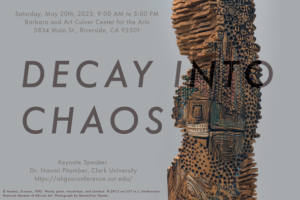
El Anatsui, Erosion, 1992. Courtesy of the artist.
The University of California, Riverside’s Art History Graduate Student Association is pleased to announce its 12th Annual Conference, Decay into Chaos. We are honored to host Dr. Naomi Pitamber, Assistant Professor, Clark University and Scholar in Residence, Getty Research Institute, as this year’s keynote speaker.
El Anatsui’s 1992 sculpture Erosion forms an intricately decaying tree; the winding structure terminates in a wreckage of fragments at the base. The recognizable form of the living tree becomes something else entirely. In a 1994 interview with art historian Chika Okeke-Agulu, Anatsui elucidates his intention in creating the sculpture: “I was not thinking of soil erosion . . . but something more basic than that, something which is at the root of it, but which is more monumental, more epochal–the erosion of cultures.” The sculpture comes to embody the concept of decay, questioning the permanence of culture. In this material manifestation of erosion, the artist understands culture as chaotic and dynamic.
The concept of decay is often linked to chaos, envisaged as an entropic disintegration. Chaos erodes the stability of orders that attempt to define people, landscapes, and materials within singular understandings of time, place, and worldview. Materials corrode, bodies degrade, traditions change, and memories fade, revealing the fallacy of a singular and constant truth. Artists and thinkers within various cultural contexts have returned to a fascination with decay as a vehicle to explore the chaos of life. Within this awareness, scholars have analyzed decay and disorder as epistemologies, addressing change and the individual’s response to it.
How have artists, scholars, and archivists defined chaos and decay? How do concepts of decay and disorder betray anxieties about the instabilities and uncertainties of change? How does their work embody and respond to the fragility of systems? How do they reconstruct memory in the face of loss? Does decay always lead to chaos? How do these conditions enable new potentialities to emerge? We strive to ask how the arts and humanities engage with frameworks of chaos and decay: what can a decay into chaos create?
Keynote Speaker: Dr. Naomi Pitamber, Assistant Professor, Clark University, Scholar in Residence, Getty Research Institute
Visit the AHGSA conference website for more information: https://ahgsaconference.ucr.edu/
PAST CONFERENCES
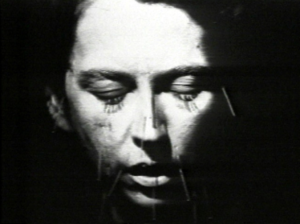
Linda Montano, Mitchell’s Death, 1977
Topic: Visualizing Love and Death Across Cultures
Keynote:Dr. C. Ondine Chavoya, Williams College
Held In-person and via Zoom
May 21, 2022
Love and death are both uniquely positioned as emotional events that significantly impact the human psyche, individually and collectively. Their distinct experiences are dictated by cultural customs and personal experience. Furthermore, developments in academia, such as the rise of phenomenology, the affective turn, and consciousness of non-Western ideologies, have changed how scholars analyze and relate to emotional stimuli. Love and death are prescient topics of contemplation, as COVID-19 has made mass death a global experience: communities engage in rituals of mourning, practice love through protest, and navigate companionship across digital media.
What can the arts tell us about contextual understandings of these two concepts, or how they often exist simultaneously, symbiotically or otherwise? These concepts call into question our ever-shifting relationship with emotions. Our understandings of these emotions, such as love and infatuation, or trauma and mourning, are dynamic. Love and death occupy a similar emotional space: both have the potential to be all-consuming, emotional, physical, restorative, or destructive.
To explore the relationship between love and death within the field, art historians often employ an interdisciplinary approach, turning to queer studies, ethnic studies, and anthropology, among other disciplines. How do our religious customs, subjectivities, and ritual practices create a dialogue between love and death? This conference seeks to create a framework for discussion of what relationship love and death could hold by bringing together scholars working on one or both of these concepts.
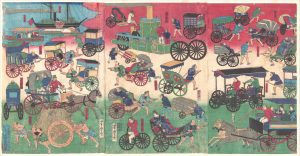
Utagawa Yoshitora, Vehicles on the Streets of Tokyo, 1870. Courtesy of the Metropolitan Museum of Art.
Topic: (Art)iculations of Proximity and Mobility
Keynote: Dr. Cheryl Finley, Associate Professor, Department of the History of Art, Cornell University
Held virtually via Zoom
May 14 and 15, 2021
The ongoing COVID-19 pandemic has separated and grounded people across the globe to varying degrees over time. It has introduced new notions like the “essential worker”—defined by their closeness to the crisis—and “6 feet” as a safe amount of nearness. It has illuminated mobility and immobility as both privilege and inequality—when some, for example, have the means to flee high-risk environments, while others don’t, and some have the option to stay home, while others must continue to move and engage person-to-person for their livelihood.
The significance of proximity–understood as nearness in space, time, or relation–and mobility–the ability to move or be moved freely and easily–as both conditions and concepts is perhaps more apparent than before. In fact, art history as a discipline is impacted by certain ideas of proximity and mobility: from early historians’ belief in “distanced” or “objective” narratives; to the methodology of “close-looking”; to the “aura” of the site-specific object; to the importance placed on travel in research. This conference asks: how have “the arts”—defined broadly and including visual and material culture—been shaped by proximity or mobility, and how have they articulated their own vision of closeness and movement as conditions or concepts? What can they tell us about how proximity and mobility have been valued, ignored, related, defined, interrogated, or challenged across time, places, and peoples? Why do these (art)iculations matter? This conference speaks to these and related questions, and encourages discourse from across the disciplines and with an expansive notion of the arts.
Keynote Speaker: Dr. Cheryl Finley, Associate Professor, Department of the History of Art, Cornell University
 Topic: Re-vision: Myth, Memory, and the Gendered-Self
Topic: Re-vision: Myth, Memory, and the Gendered-Self
Keynote: Dr. Charlene Villaseñor Black, UCLA Department of Art History
The goal of the conference is to promote an interdisciplinary dialogue through visual and material culture by questioning imposed gendered hierarchies and identities, in order to facilitate inclusive understanding of gendered roles in myth throughout history. This year’s theme concerns re-vision–revising, re-conceptualizing, and seeing differently –as the act of “looking back” to forge new critical directions and critique androcentric world views and traditions. Concepts of gender within oral histories, literary traditions, cosmologies, and visual arts –and the relevance of gender’s constant fluidity –helps to shape our understanding of the world. This understanding becomes a cultural mythology that affects our contemporary memory. Though these mythic stories shape human experience (by informing cultural identity, world views, social structure, self-image), they themselves are not fixed. Continuing in the tradition of rewriting and challenging the historical canon, the reclamation of the distorted-self (distorted by fixed, limiting, and systematized gender concepts) is necessary for the troubling of myth and legend within the visual arts. Questioning conventions, perceptions, and conceptions of gender in art is necessary to recover the agency that mythic images of identity evoke. This conference will explore the ways in which concepts and representations of gender in myth are revised through art and art history. Such re-visioning takes on urgency when images themselves act as sites of active engagement –a dialogue between viewer and viewed –which will therefore serve to restructure human experience, history, culture, belief and understanding. We are interested in the re-evaluation of androcentric mythological imagery, the functionality of gender (theoretically and iconographically), and how gender has been radically reworked within visual culture, which thereby constructs a contemporary memory. Additionally, it will consider how myth and contemporary memory are now being shaped through movements such as the #metoo movement, Black Lives Matter, the LGBTQ+ community, immigration issues, spirituality, modern witchcraft, and more. It will look at new critical directions and assertions in cultural history and how visual culture is reworked through time, across global traditions –historical to contemporary, mainstream to margin.
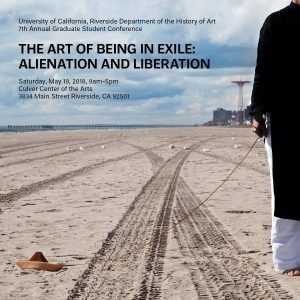 Topic: The Art of Being in Exile: Alienation & Liberation
Topic: The Art of Being in Exile: Alienation & Liberation
Keynote: Dr. Tatiana Flores, Associate Professor in the Departments of Art History at Rutgers University
Exile involves anything that precludes a person from inhabiting or experiencing a condition of establishment. Thus, exile can be self- or externally-imposed, natural or voluntary, and come about for a wide variety of reasons such as: politics, ecology, economics, safety, ideology, sexuality, religion, or expatriation for study/work/security purposes. Although exile often has negative connotations, it can also be liberating for some individuals, particularly if they were established in a place or manner that prevented them from expressing their true selves or beliefs.
Exile is a state or condition not bound to a specific place or time. Because of its strong impact on the people living through it, exile has inspired works of literature, theater, music, and the visual arts. Ostracism was a punishment considered worse than death in Greek literature. Shakespeare inflicted banishment on many of his characters. Napoleon Bonaparte’s court painter Jacques-Louis David was exiled in Brussels following the Bourbon restoration, and while there, produced extraordinary portraits of fellow exiles, supporters of the deposed emperor. Hungarian-born László Moholy-Nagy, a central figure at the German Bauhaus School in the 1920s, went through several self-imposed exiles as he sought creative freedom and inspiration. In 1935, in response to the rise of National Socialism, he relocated to London, and then again to Chicago. The Argentine Leon Ferrari was forced into exile in Brazil in 1976 because of his political artworks in opposition to the military dictatorship, which also disappeared his son Ariel the year after. Nidaa Badwan opted for a year-long voluntary exile in 2013, retreating to her room in Gaza, which she rarely left. There, she created a photographic self-portrait series that leaves the chaos outside, to the streets of Gaza.
At a time when war, natural disaster, ecological devastation, famine, and intolerance continue to drive hundreds of millions of people out of their homeland, the conference aims to be a platform of dialogue to explore this phenomenon and its complex implications. Questions we seek to consider include: In what way do artists engage with the experience of exile, where gender, sexuality, and ethnicity, assume new connotations? Under which conditions can exile art open a dialogue on issues of gender, sexuality, ethnicity, nationality, and the status of immigration?
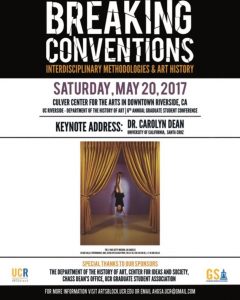 Topic: Breaking Conventions: Interdisciplinary Methodologies and Art History
Topic: Breaking Conventions: Interdisciplinary Methodologies and Art History
Keynote: Carolyn Dean, Professor in the Department of History of Art and Visual Culture at the University of California, Santa Cruz
CFP: Since the 1970s, “outside” methodologies derived from fields as diverse as anthropology, religious studies, literary theory, media studies, sociology and the sciences have been increasingly absorbed into art historical discourse, irrevocably altering the perception, reception and even definition of works of art. The introduction of interdisciplinary approaches to the conversation challenged the traditional model where style and attribution, cultural context and connoisseurship, iconography and social history were considered the central approaches to analyzing art. This momentous shift away from the more conservative canon and methodologies has proven to be a vital means for expanding the boundaries of art history as a discipline.
In the context of the growing emphasis on interdisciplinary approaches across academic scholarship, this conference will consider the continuously evolving nature of art historical research. How have methodologies from other disciplines enhanced, redirected and fruitfully challenged the ways in which art historians view, describe and interpret works of art? This multi-disciplinary conference seeks papers that examine the impact of new and interdisciplinary methodological approaches on our understanding of artworks, visual cultures, and the discipline of art history proper. Papers from all geographical areas, historical time periods, and methodological perspectives are encouraged.
Questions we seek to consider: How have methods outside of art history affected the art historical canon? How do current methodological shifts change the ways in which we approach art objects? How have non-art historical methods prompted us to see “traditional” artistic media, such as painting and sculpture, anew? Alternatively, do traditional art historical methods have the potential to encourage an expansion of the art historical canon?
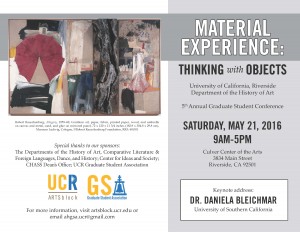 Topic: Material Experience: Thinking With Objects
Topic: Material Experience: Thinking With Objects
Keynote: Dr. Daniela Bleichmar, Associate Professor in the Departments of Art History and History at the University of Southern California
CFP:
New theories in art history, cultural studies, and philosophy have recently called attention to the power of matter in shaping our perception of the world. However, attention to materiality is nothing new. For example, in the 12th century, Abbot Suger defended his extravagant art program at St. Denis in part by inscribing on its doors that “the dull mind rises to the truth through material things.” Suger’s statement makes clear the profound and illuminating potential of material objects that has persisted, in varying forms, throughout history.
However, James Elkins has observed recently that fields of visual studies are characterized by an enduring disparity between written theories about objects and the embodied experience of one’s encounter, indicating more broadly what he calls a “fear of materiality.” At a time in which our experience of art, architecture, and other objects in visual culture is often physically removed through their circulation as digital images, this topic arrives with a detectable urgency. How should we in turn experience the things of the world? This multi-disciplinary conference will address how the material conditions of objects invigorate social, political, and aesthetic spheres.
Questions we seek to consider: What role does materiality have in shaping our perception of objects? How do emerging or established theories of materiality impact art history, visual studies, and other disciplines? And, accordingly, what are the limits of these theories? Do the means of production and exchange alter our perception of the material object? And finally, how does art, regarded as material culture, function as historical evidence?
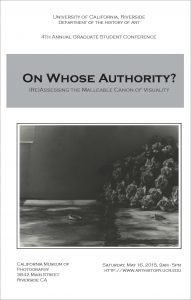 Topic: On Whose Authority? (Re)Assessing the Malleable Canon of Visuality
Topic: On Whose Authority? (Re)Assessing the Malleable Canon of Visuality
Keynote: Dr. Rafael Cardoso, Getty scholar and Professor at Universidade do Estado do Rio de Janeiro
CFP:
Although the term canon implies rigidity, internal and external pressures have often forced canons to be re-evaluated and reformed. A look at art and objects on a global scale, from past to present, inevitably reveals the complexity as well as the exclusionary quality of canonicity. As such, a canon can be shown to have a malleable nature, one that yields or resists challenges to authority. Because the concept of a canon in relation to visuality permeates a wide variety of disciplines, this multi-disciplinary conference seeks to explore the relationship between canonicity and the arts, in any of its forms, within an expanding, global context.
Giorgio Vasari, the author of The Lives of the Most Eminent Italian Architects, Painters, and Sculptors, is commonly regarded as one of the “fathers” of art history. Vasari’s sixteenth-century project aimed to document the technical progress of artists over time and to establish the superiority of Florentine art, thus constructing the first canon of art history. As discourses about aesthetics, representation, and politics developed, scholars and artists alike began to question and challenge the seemingly purposeful exclusion of various identity groups from discussions of the visual arts. Investigations of the canon, however, are not limited to who is included or excluded. Rather, the inclusion and valuation of media is also an important topic to address. Consider, here, the perceptions of photography upon its invention in the early 19th century. These examples, while not exhaustive, serve to demonstrate our interest in the malleable nature of the canon within the context of the arts.
Some of the questions we seek to address include: What role(s) does the canon play within a globalized art history or study of the arts? What are the implications of reevaluating the canon? Who, or what, determines the canon? How does the canon demonstrate points of intersection and divergence among academic disciplines? How does an examination of the canon illuminate historical and ideological shifts? How have its parameters shifted as the discipline of art history has changed? Approaches to these questions could come in the forms of fine art, historical objects and documents, art history, fashion, design, architecture, visual culture, literature, religious objects, artifacts, and many more.
 Topic: Exchange: Assimilation and Appropriation in the Arts
Topic: Exchange: Assimilation and Appropriation in the Arts
Keynote: Sofia Sanabrais, Getty Research Institute Scholar and lecturer in the Department of Art History at the University of Southern California Saturday
CFP: From antique and early modern forms of trade, exploration and colonization to more modern forms of cultural contact through immigration and the development of the internet, cultural exchange continues to have an impact on the construction of the arts and art trends around the world. This multi-disciplinary conference seeks to explore the relationship between assimilation and appropriation in the arts, in any of its forms, from antiquity to the contemporary.
Sophisticated networks of trade, world exploration and cultural sovereignty established and experienced throughout antiquity and the early modern period changed local arts and impacted cultural exchange. This form of contact can be traced back as early as 700 BCE, as influential Greek colonies were established in what is today known as Italy. Similarly, the Dutch invasion and colonization of Indonesia during the seventeenth century also had a major lasting impact on the cultural makeup of the region. Cultural exchange has not been limited to physical avenues, however, and the movement of ideas by visual forms of exchange has fostered artistic inspiration and aesthetic amalgamation. For example, upon encountering African masks in Parisian museums, Pablo Picasso appropriated certain African aesthetics for his cubist studies. Similarly, late nineteenth century American artist William Merritt Chase borrowed motifs inspired by Japanese prints and ceramics. These brief examples serve to demonstrate our expanded approach to the idea of assimilation and appropriation as integral aspects of artistic and cultural development, absorption or resistance.
Among the questions we seek to address are: How may cultural and aesthetic authenticity be threatened by the loss of national identity? How have methods of appropriation and vehicles of distribution changed over time through the development of transportation, mechanical reproduction and the internet? What is the overall lasting impact of various forms of exchange, whether experienced through personal travel or cultural invasion, whether accepted or unwelcome, whether voluntary or forced? Approaches to these questions could come in the forms of fine art, fashions, foods, design, architecture, literature, race, religion, and many more.
Keynote: Britt Salvesen, Curator of the Wallis Annenberg Department of Photography and the Department of Prints and Drawings at the Los Angeles County Museum of Art
CFP: Repetition, as both logic and device, has played a significant role in the history of art. As logic, repetition underlies the very possibility of artworks as meaningful objects, as it is through repeated acquaintance with an object or form that it gains meaning in a prescribed context. And as stylistic device, the use of repetition has transcended historical periods and visual cultures. From prehistory to the present, the repetition of forms and objects has been used by practically all cultures as a way to define common identities, establish order, and inscribe sense and meaning into the world. The use of repeated forms stands at the center of, for instance, practices and objects as distinct as Inca tunic design, Buddhist and Hindu mandalas, Outsider art and 1960s Minimalism. Yet repetition was also part of painterly strategies in the Renaissance and Baroque periods and pervades the concepts of Early Modern print culture as well as sculptural practices. These various examples serve to highlight our expanded approach to the idea of repetition as an integral aspect of a series of diverse practices, including pattern design, seriality, doubling, mirroring, symmetry, recursion, copying and reproducibility.
Moreover, the significance of repetition extends to the present moment as the concept has occupied an important place in the theorizing of modern existence—as commodity or behavior, for instance. More specifically within the visual arts, the advent of photography in the mid-19th century has led thinkers to theorize the effects of the repeated and repeatable image in modern life, often with inconclusive or contradictory results. While Benjamin argued in 1936 that, “the technology of reproduction detaches the reproduced object from the domain of tradition,” making a case for the revolutionary potential of the technology of photography, Adorno and Horkheimer contended some years later that in contemporary existence, “what is new is that the irreconcilable elements of culture, art and distraction are subordinated to one end and subsumed under one false formula: the totality of the culture industry. It consists of repetition.”
Keynote: Steve Hindle, W.M. Keck Foundation Director of Research, Huntington Library, “Representing Rural Society: Surveyors, Surveying and the Surveyed in Seventeenth Century England”
CFP: Academic scholarship rarely fits neatly into the confines of a single disciplinary label. Many academic studies cross between disciplinary, regional and temporal borders. For example, Italian Renaissance studies examine a geographic region made up of independent city-states that were not, at the time, considered a single region. Anthropologists in Latin America and Asia consider cultures that are inextricably linked with other cultures by trade over hundreds of years. Many musicians cite painters as sources of inspiration, and painters are in turn, influenced by performance theory. When considering the influence of medicine, anatomy and nature on artists, the divide between the humanities and sciences is also blurred. It is the multiplicity of these academic categories that we wish to celebrate with “Traversing Borders.”
Graduate students in any discipline are invited to submit abstracts for “Traversing Borders,” the first Annual UCR Art History Graduate Student Conference, on May 12, 2012. The conference provides a forum for graduate students to question borders and boundaries—to delineate, critique, move through or reconfigure their role in the analysis of art and art history. Contributions engaging any medium (armor, dance, sculpture, print media, photography, architecture, film, painting, performance, etc.), time period, race/ethnicity, gender and region are welcome.
Papers may consider the notion of boundaries and borders in relation to artistic production, historiography, methodology or reception. How does art create, embody and respond to borders? How do artists transgress and navigate racial, political, economic or gendered boundaries? How are boundaries imbued with an ideology marking objects or gendered boundaries? How are boundaries imbued with an ideology marking objects as appropriate to the study of art history? What role do boundaries play in the scholar’s project? What is the role of borders in maintaining ideologies, economies and politics? Do borders always locate difference?


